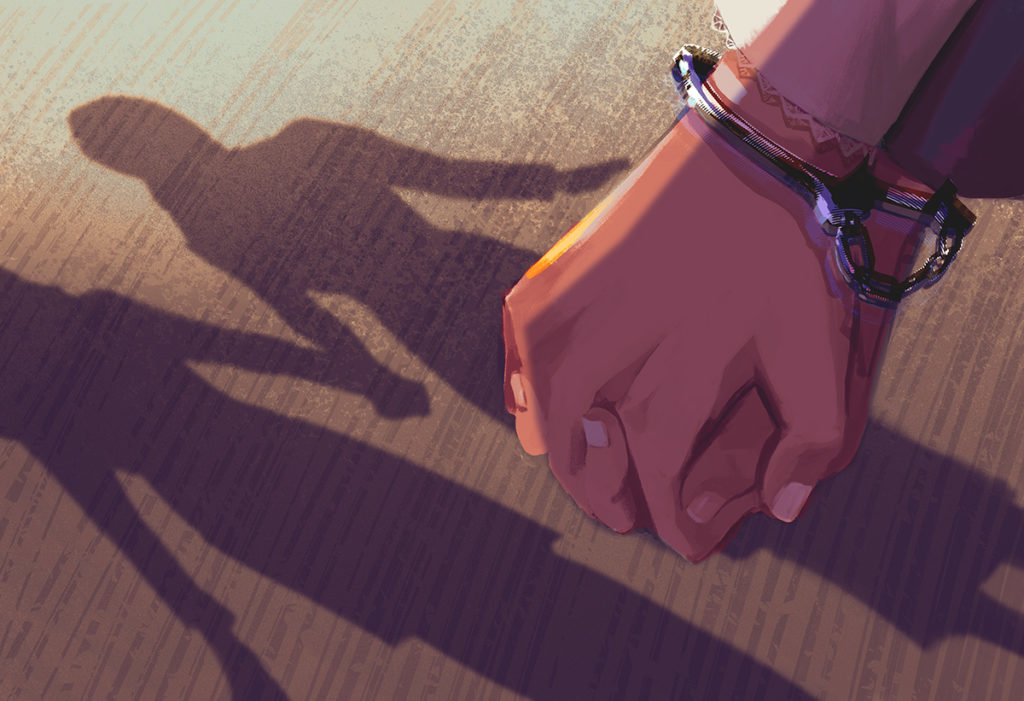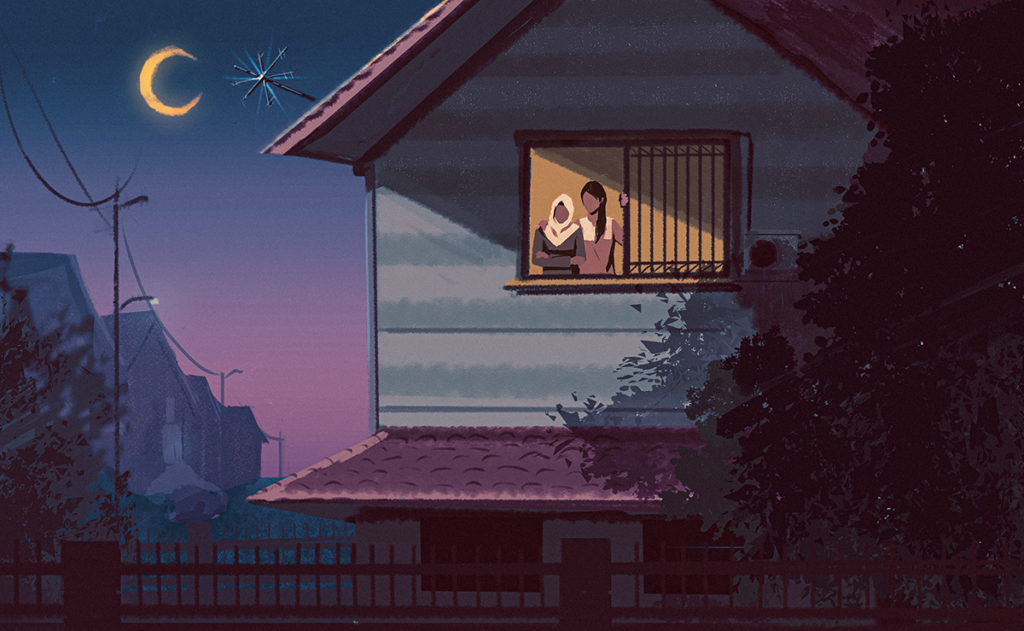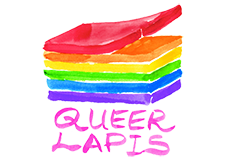How Lesbianism Became a Crime in Malaysia
by MS. A. HAQAH | 20 Dec, 2020

LAWS CRIMINALISING FEMALE same-sex desire have never been common in comparison to laws criminalising male same-sex desire. Under the patriarchy, understandings of sexuality have almost exclusively centred on men, in particular cisgender, heterosexual men. As a result, the sexual desire of women and non-cisnormative and non-heteronormative identities have, by and large, historically been ignored, or, worse, persecuted and criminalised. Often, then, within this patriarchal context, “unnatural” desire is constructed as homosexual male desire, rendering gay women invisible. This invisibility, however, is not all bad, lending itself well to safety. In invisibility, women are less likely to be persecuted for “unnatural” desires—at the price of being written out of most of history (but that’s a discussion for another time).
Malaysia, however, stands out as one of the forty-five countries which explicitly criminalises lesbianism. This criminalisation is notable because of the way it is constructed: only Muslim women are addressed, through Syariah laws criminalising musahaqah, or, as it’s generally defined, “sexual relations between female persons.” It is important to highlight the general wording of the law focuses on relations, beyond just intercourse—meaning desire—desiring to be with other women, in and of itself, as a woman—is illegal. (Throughout this piece, female same-sex desire will be based off of the state’s definition of female, which would refer to cisgender women and persons assigned female at birth.)
But why does the Malaysian government have such a stake in this issue?
In a previous post on Queer Lapis (What Laws are Out to Catch You?), Malaysia’s dual justice system was elaborated to explain which laws applied to whom. While Section 377 of the Penal Code is applicable to all citizens, it’s mostly, if not exclusively, used to persecute men. However, all but one state has a Syariah law against lesbianism. These laws are also a modern invention, introduced from the 1980s onwards. The state criminalisation of musahaqah, then, is further curious because it’s hard to make sense of why Malaysia needs a law to target queer Muslim women directly. Why not all queer women? Or, alternatively, why not just ignore all of them?
The issue is complex and, like most issues in our country, has a messy link to our colonial past, and our desire to differentiate ourselves from “the West” as well as our colonial history. To understand how this criminal category came about, it becomes important to unpack Malaysian society, culture, and the government’s stake in curating an imagination of Malaysia as heterosexual.
Criminalisation in Malaysia, for the most part, is justified based on passages from the Quran which are interpreted as condemning lesbianism.
However, there doesn’t seem to be consensus on which texts in particular condemn lesbianism.
Here, I will examine the passages that Malaysia uses to condemn lesbianism and compare them to the passages used in Iran, which also condemns lesbianism.
The official Federal Territories’ (FT) Mufti’s website specifically cites surah al-Mu’minin (5-7) as explicitly forbidding lesbianism:
“And they who guard their private parts except from their wives or those their right hands possess, for indeed, they will not be blamed—but whoever seeks beyond that, then those are the transgressors.”
The Mufti argues this forbids lesbianism because if a woman exposes her private parts to anyone but her husband, she is amongst the transgressors and a sinner as such. However, it is clear that the surah does not explicitly mention lesbian sexual behaviour as impermissible—in fact, by mentioning ‘wives’, the verse seems to be specifically speaking to men. The interpretation of the Mufti that this verse also addresses women, and specifically queer Muslim women, is quite generous. Nothing about the passage directly condemns lesbian sexual desire—it seems to condemn all sexual desire outside of marriage. Thus, it must be questioned why this verse is read as applying to queer Muslim women, when the verse makes no distinction between heterosexual or homosexual acts.
Further, the Department of Islamic Development of Malaysia (JAKIM) and the official FT Mufti also quote a hadith where the Prophet is narrated as saying, “When a woman come [sic] unto another woman (sihaq), both of them are adulterers.” Generally, this hadith seems to suggest that the punishment for women laying together sexually is the same punishment as adultery. However, again, it is unclear whether the sinful act is a woman coming unto another woman or the fact that it is occurring outside the confines of marriage, thus equal to adultery.
Iran, on other hand, uses completely different passages which refer to fahisha, which is a Quranic term used for strongly condemned immoral behaviour that is pursued for egoistic goals. Scholars Bucar and Shirazi note that the term is used throughout the Quran, and not just in sexual contexts; but the Iranian Courts have expanded the meaning to capture lesbian sexual behaviour as well, justified by their interpretations of Islamic texts.
Why does it matter if Iran uses different texts to condemn lesbianism?
It matters because it suggests there is no universal agreement in Islamic legal tradition that same-sex acts between women are condemned. By contrast, if we asked a Muslim where in the Quran same-sex acts between men is condemned, there would be near-universal agreement that it is in Lot’s story (it is important to note despite there being near-universal agreement does not mean there is true consensus on this interpretation of Lot’s story. As it stands, criminalisation and persecution based on contested interpretations of the text remain unjustifiable).
The lack of consensus over an explicit passage which condemns lesbianism in Islam suggests, then, that the criminalisation of lesbian sex acts under Syariah laws are likely culturally constructed.
It’s also important to note that the term musahaqah, which is used in Syariah law to refer to lesbians and lesbianism, is never explicitly mentioned in the Quran. It is an Arabic word meaning ‘to rub’, meant to refer to the action of two women engaging in a sexual act. It is interesting how the word “rubbing” becomes interchangeable with lesbianism and subsequently framed as a crime. Clearly, cultural values too have been rubbed together in order to give meanings to laws and fulfil the desires of governments.

For laws to have cultural value, it means the Government has a stake in the morals of the society.
Before we delve into the moral value that the Government wants to shape, it’s crucial we also understand the instrument that the Government uses to assert this moral. Here, I’d like to take a moment to briefly explain the theological underpinnings of Syariah Courts.
This section is quite technical—but bear with me. It will make sense, I promise.
Syariah Courts enforce Syariah laws, which forms the standard code of life for Muslims. Traditionally, however, there is no single unified Islamic legal code, be it in Malaysia or even the world. This tradition differs from Western legal canon because of the recognised diversity of interpretations of the Quran and hadiths. This recognised diversity forms the basis of usul al-fiqh, or Islamic legal theory. Within Islamic legal theory, the basic instrument of change is the fatwa. Fatwas represent “the legal opinion of a fallible scholar”, and are context- and community-specific rulings. Crucially, though, fatwas were “not considered an infallible statement about the Will of God.” The key feature of the evolution of Islamic jurisprudence was that it was a “bottom-up, not a top-down process.”
Islamic legal tradition in Malaysia differs from the theological roots of Islamic legal tradition outlined previously because Islamic law was first institutionalised by the British during the colonial era to appease their Malay-Muslim subjects. Muslim law, as the British called it, was introduced to give Malays control over family law. Scholars call this type of law ‘Anglo-Muslim law’—Anglo because it follows English common law and Muslim because it applied to Muslim subjects. Hooker remarked that a classically trained Islamic jurist would find it difficult to navigate Anglo-Muslim law, whereas a common lawyer with no knowledge of Islam would be comfortable. Crucially, though, in following the structure of English common law, Malaysia’s religious authorities abandoned the principles of usul al-fiqh–recognising the rich diversity of interpretations of Islamic texts–and replaced these with a state sanctioned interpretation, with little room for contestation.
Post-Independence, as part of the Islamisation of Malaysia…
A Constitutional amendment was passed in 1976 to replace every iteration of “Muslim law” with “Islamic law.” This amendment also changed “Muslim Courts” to “Syariah Courts.” This simple semantic shift created Syariah Courts in Malaysia as they are known today, functioning to pave the way for the state-led Syarisation project.
As part of the Islamisation process, fatwa committees, led by an official Mufti, were also institutionalised. The official Mufti has the power to release official fatwas. Recall, fatwas are only fallible opinions of scholars.
In the process of institutionalising the administration of Islam in Malaysia, fatwas were transformed from opinions to legally binding instruments of the state. In doing this, the key feature of Islamic jurisprudence changed, altering the bottom-up creation of knowledge into a top-down ruling, backed by the full force of the law.
While the process of creating a legally-binding fatwa is complicated, it is still criticised as a “[deviation] from Islamic legal theory and practice.” While there is no explicit fatwa against musahaqah, there exists a fatwa declaring pengkids haram. The JAKIM Director-General at the time described a pengkid as “a married woman or maiden whose appearance or image is like that of a man” or, generally, a woman who behaves like a man, regardless of appearance. He also mentioned that pengkids may have a sexual desire for women but asserts that this might not necessarily be true for all pengkids, framing the fatwa as more of a preventive measure against lesbianism (“We are trying to save these women”). The broad definition of a pengkid is likely purposeful in order to capture a large scope of behaviours the National Fatwa Committee sees as indicators of lesbianism. The actual phrasing of the fatwa (“wanita yang berpenampilan dan mempunyai gerak laku serta naluri seksual seperti lelaki”) demonstrates how religious authorities often conflate gender identity and sexual orientation, making the assumption that physical appearance is a proxy for sexuality. This fatwa has been gazetted by seven states (Melaka, Johor, Wilayah Persekutuan, Pulau Pinang, Kedah, Perak, Terengganu), meaning it is as good as law in these states for Muslim women. It is important to note, however, though the fatwa explicitly mentions women, the brunt of this targetting falls on trans masculine and gender diverse people. Nonetheless, this fatwa remains the official Malaysian stance as it was passed by the National Fatwa Committee, condemning behaviours seen as proxies for lesbianism and reinforcing the criminalisation of queer Muslim women.
Through Syariah Courts, the government is able to construct and enforce a moral code for its Muslim majority—a moral code which is explicitly heterosexual. Why target Muslim women, though? In order to explain this, we have to look at how this plays out through culture.
Up to this point, I have outlined the Government’s dual desire to culturally construct a particular interpretation of Islamic texts condemning lesbian sexual desire and acts while asserting an enforceable and exclusively heterosexual identity.
To understand how this links to our culture, we must unpack Wahab’s idea of homophobic nationalism.
Homophobic nationalism is a state-sanctioned response which occurs in post-colonial contexts to confer legitimacy to the current regime. This occurs by targeting LGBT identities and punishing them to construct a national identity outside of Western influence, where LGBT identities are Othered as a Western phenomenon. Homophobic nationalism in Malaysia occurs by denying the existence of LGBT identities and is heavily promoted by Malaysian politicians.
Mahathir, the architect of the Islamisation of Malaysia, has always centred his political rhetoric on shunning Western values for “Asian values.” Acceptance of the LGBT community is considered a Western import, with Mahathir arguing, “Why should we follow that? Our value system is as good.” In blanketing this as a “values” issue, the West is fashioned as an imposing, oppressive power to which Mahathir stands up by rejecting ideas he considers as attempts of neo-colonialism, such as suggesting the LGBT community are human beings with rights. Doing this serves two purposes. First, it is empowering, extending legitimacy to Malaysia as more than just a former colony. In being a small country that defies the demands of the West, Malaysia constructs itself as an equal, with a value system that is as good, as valid, as legitimate. Second, it enables the construction of an ideal Malaysian identity, outside the demands of the West, thereby distancing Malaysia from its colonial legacy. That all of this occurs at the expense of the LGBT community is just collateral—a price politicians are more than willing to pay. This is a party line towed regardless of political affiliation. We have all seen the countless articles of our politicians saying hateful, ignorant things about the LGBT community in Malaysia.
Thus, the Government’s desire to culturally construct an interpretation of Islam that condemns lesbian desire rests in their desire to construct an ideal Malaysian identity that differentiates itself from the West, the former colonisers. Marginalised already, the LGBT community becomes an easy target.
But what is special about the targeting of Muslim women?
The heart of framing the issue of recognising LGBT rights into a Western-versus-Asian values debate transforms the conversation into one about moral values. While we are a secular country, it is no secret that Islam holds a special space in Malaysia. Muslims, by extension, are constructed by the Government as the bearers of morality, a mirror of our upstanding moral society, different from the budaya kuning of the West. Muslim women have a role to play in upholding this moral value, no different than Muslim men.
Part of this moral value is heterosexuality, opposing the multiplicity of sexualities which our Government would have you believe are only found in the West.
In the absence of explicit condemnation of lesbians in the Quran, it became imperative for the Government to fill this gap, using instruments of the state to create a criminal category for queer Muslim women in Syariah law and enforce the criminalisation through Syariah Courts. This is how morality is created, governed, and policed in Malaysia.

The construction of the ideal Malaysian identity as heterosexual, in addition to homophobic, of course, is a fantasy. It is a dangerous fantasy with real implications for queer Muslim women. In Dina Zaman’s book I Am Muslim, she interviews Hajah, a woman with same-sex desires, who prayed for God to take away her sexuality when she was completing her Hajj because she felt her religion was incompatible with her desires. Dina also highlights the experiences of tudung lesbians, who questioned how they were gay when they were raised as good Muslims. Scholars such as Jerome have argued that these women were unable to embrace their queer identities because they were unable to resolve the conflict between their faith and their sexuality—but how can one even attempt to reconcile their faith and their sexuality when their Government tells them they are not only wrong, but illegal? Highly visible punishments such as the public whippings meted out to the women who were caught in Terengganu serve as a reminder to queer Muslim women that their identities are, indeed, punishable. All of this creates a dangerous and toxic environment for queer Muslim women.
Queer Muslim women are clearly not the only identities the Government criminalises. This issue, sadly, functions only as a subset of a larger issue which extends beyond the persecution of queer Muslim women. The deep irony in Malaysia constructing nationalism rooted in homophobia as a response to colonialism is how they have used the very institutions the colonisers left behind to shape and assert this identity. In legally binding Muslims to laws that criminalise homosexuality, the government attempts to assert a moral identity for its citizens, one diametrically opposed to the West, championing “Asian values”, where the LGBT community is erased, where homophobia is subsumed into the national character, at the unacceptable cost of marginalising and endangering whole swaths of the population.
~ ~ ~
Ms. A. Haqah is a pen name. She works as a banker and loves to bake and bird watch (#MNS). Her favourite bird is the orange bellied leafbird because, from certain angles, the females can look like mangos.
References:
- Boellstorff, T. (2006). Domesticating Islam: Sexuality, Gender, and the Limits of Pluralism. Law & Social Inquiry, 31(4), 1035–1053. doi: 10.1111/j.1747-4469.2006.00046.x
- Bucar, E. M., & Shirazi, F. (2012). The “Invention” of Lesbian Acts in Iran: Interpretative Moves, Hidden Assumptions, and Emerging Categories of Sexuality. Journal of Lesbian Studies, 16(4), 416–434. doi: 10.1080/10894160.2012.681263
- Hooker, MB. (2002). Introduction: Islamic Law in South-East Asia. Studia Islamika, 10(1), 213–231. doi: 10.15408/sdi.v10i1.636.
- Jerome, C. (2013). The Complexity Of Malay Muslim Identity In Dina Zaman’s I Am Muslim. GEMA Online® Journal of Language Studies, 13, 169–179.
- Moustafa, T. (2018). The Secular Roots of Islamic Law in Malaysia . In Constituting religion: Islam, liberal rights, and the Malaysian state (pp. 31–48). Cambridge, UK: Cambridge University Press. doi: https://doi.org/10.1017/9781108539296.003
- Wahab, A. (2012). Homophobia as the State of Reason: The Case of Postcolonial Trinidad and Tobago. GLQ, 18(4), 481–505. doi: https://doi.org/10.1215/10642684-1600707

